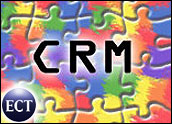
Attracting and retaining fans are the keys to success in the crowded and competitive online games industry. The Net’s growing multimedia communications capabilities are providing not only games developers but businesses of every size and stripe a vastly richer yet less structured environment for CRM; something game developers and distributors are very much aware of and keen to plug into.
The emergence of massively multiplayer online games presents online games developers with unparalleled opportunities to reach a worldwide audience of primarily young, highly motivated fans. Attracting them and keeping them coming back requires extra effort, however.
“Customers in the video game industry tend to be young. They tend to prefer communication through electronic channels such as e-mail, chat and Web self-service, rather than the phone. In fact, our clients in this sector are experiencing significant growth in the volume of customer communications through these channels. This means that businesses in this sector need to have a high degree of competence, especially in handling e-channel customer communications — this is often called ‘eService,'” eGain’s vice president of worldwide marketing, Anand Subramaniam, told CRM Buyer.
Keeping It Fresh
Good CRM is vital to an online game’s success, according to Patrick Pligersdorffer, CEO of Cyanide Studio. “CRM is really important because the current online game economy is based on a recurring monthly payment model or micro-payments, item-by-item, for example.
“In the first example, the key to success is to secure the loyalty of ‘clients’ so as to prolong the length of their subscription. So you have to keep coming up with new ideas to get them to stay: in-game animation, new content, competitions. It’s like a brand of clothing that has to bring out a new collection each season so as to renew customer interest.”
Paris-based Cyanide started its commercial life in 2000 with the release of “Pro Cycling Manager”, a real-time, 3-D online simulation that enables users to create teams and participate in the running of 180 of the world’s biggest bicycle races, including the Tour de France.
“The game was designed from the get-go with the community in mind. In the end, for market reasons, it was released as a solo game with a strong multi-player component. It’s probably the latter that helped ‘Cycling Manager’ become a long-lasting series,” Pligersdorffer recounted.
“Our community has been very supportive, creating new jerseys, new races, etc. … That’s something that we have always tried to develop for all our games. We tend to be active on our forums, provide tools whenever possible. As a developer, I think we are very close to the gamers that play our games. Moving into MMOG (massively multiplayer online games) is then a logical step for us.”
Looking to follow up on the success it has had with “Cycling Manager,” Cyanide Studio is busy working through the latter stages of developing “Dungeon Party,” its first MMOG offering.
Looking ahead to developing a CRM solution to support its new creation, management intends to make use of the methods and tools that have proved successful for it and other games developers.
Creating Community
Creating a community is the first step for any online games developer, Pligersdorffer explained.
“Whatever the game, whatever the product, all communities work in more or less the same fashion. They need a subject for discussion and a place to exchange ideas.”
Launching a forum, followed by a blog — which requires more input from an editor and developer(s) — is the first online channel in a game developer’s CRM toolkit. “[These provide] much more human, much more intimate contact than you get outside the gaming world.
“When you buy a pair of shoes, what chance would you have of talking to the designer to give him your ideas on the product, how to improve future models, why you like such and such a model and so on?”
Launching an official game site where the gamer can find screenshots, artwork, interviews with development team members, regular updates on the development of future games and “other goodies,” such as wallpapers and fan-site kits, is the next must-have in a games developer’s CRM toolkit, he continued
Then there’s the newsletter. “There’s a stage when the player discovers the game for the first time, and then the moment when, tired of waiting, he goes off to look for something more ‘immediate’ to satisfy his need for entertainment ‘right now,'” Pligersdorffer elaborated.
“Between these two stages, the player will have inquired about the game, will have gone through the developer’s Web site looking for ‘secret’ information that others may not have seen; will have asked a thousand questions on the official game forum, if it exists. Then he’ll get fed up and say to himself that six months, for example, is a bit long and that he’ll come back later. It’s then that you must be ready to give the player regular boosters by sending him new information on the game so as to keep up his interest until the release.”
Reaching Out in a Viral Sort of Way
Reaching out to gamers via third-party fan sites is another important aspect of CRM in the games industry, Pligersdorffer explained. “They are the voice of your game; they’re on the front line — the biggest fans, the best salesmen, and you’ve got to take care of them. They do a priceless job; they are unique and you have to maintain a special rapport with them.
“How many fan site leaders dream about being invited by the developer of their favorite game to visit the studio and meet the team — and go home with a wagon load of goodies? How many fan site leaders dream about getting a unique interview that sets them apart from other fan sites of the same game and draws the attention of the whole community to them?”
Game developers need to back up their fan site communities by maximizing game distribution, he continued. “If the publisher doesn’t do a decent job in getting the game into as many points of sale as possible, then the fan sites serve no purpose. However, when the game is only distributed online, fan sites are the key to success of communication around the game.
“It works in a viral sort of way. A member of such-and-such a guild tries such-and-such a game and talks about it on the forum of his favorite game. Suddenly, you can have a wide part of this community who become aware of your product.”
What Games Developers Need in a CRM Solution
Games developers require robust, reliable and full-featured account management capabilities in a CRM solution, according to Pligersdorffer, “especially with the micro-payment system that we shall put into place for our upcoming MMOG title, ‘Dungeon Party.’
“For that, we need robust management of player profiles, secure transactions schemes that will instill confidence, a log of payments, etc. We haven’t yet decided what we’re going to use as a back-end platform as we’re still some way off from having a finished game.”
Routing queries to appropriate agents, enabling agents to answer those queries effectively and efficiently through knowledge bases, coupled with workflow management systems that support problem resolutions are key aspects and indicators of eService proficiency, added eGain’s Subramaniam.
That happens to be what eGain strives to deliver with its multi-channel customer service and knowledge management technology. “The solution enables intelligent routing and handling of customer queries through interaction channels such as e-mail, chat, Web self-service and phone while ensuring service quality, continuity and consistency across channels.”
Online games also offer a wealth of opportunities when it comes to data mining and business intelligence. While it isn’t involved in the business intelligence or data mining space, eGain’s solution “can mine the multi-channel interaction history of customers, and in conjunction with our Inference reasoning engine, suggest next best steps to agents at the point of customer service. These steps may include asking the right follow-on question for problem resolution, cross-selling, up-selling, etc.,” Subramaniam explained.
CRM in an Age of Instant Gratification
Close and regular interaction between the company and players is what distinguishes CRM in the games industry, Pligersdorffer and Subramaniam concurred. “These users are technology-savvy and come from the age of ‘instant gratification.’ Therefore, agents need to be highly knowledgeable, and Web self-service needs to be very effective,” Subramaniam commented.
“What sets game CRM apart from other industries is the capacity to be able to speak with the development teams. It gives the ‘client’ a real impression of having an input into the product’s evolution, and that’s really important,” Pliggersdorffer added.
“You’ll see an ‘imperfect’ product which doesn’t give the impression that it will evolve or change and an ‘imperfect’ product that will evolve because somebody on a forum gave a good idea that will be exploited. That gives the impression that anybody can change a product according to his desires — and it’s not just an impression, it’s reality.
“I’d say that in the games industry, CRM essentially relies on the quality of entertainment that you are capable of offering to your ‘public’ and on your capacity to listen to your community [in order] to improve what already exists. In turn, that will condition the quality of the entertainment.”





















































Social CRM
See all Social CRM